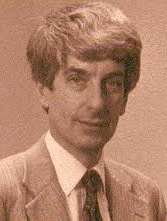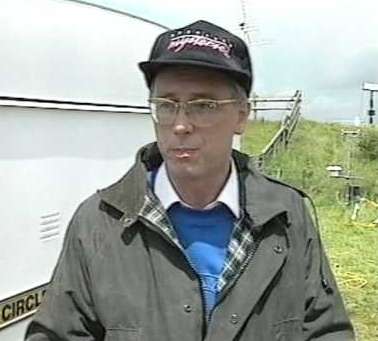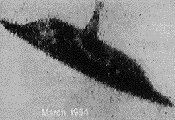A few close criticisms of the constructive kind …
Originally published 20 January 2011

I was just a kid when Close Encounters came out, but I remember thinking, even then, how cool it would be to have a serious, well-equipped government operation like the one depicted in the film. A bit unusually for its time, Close Encounters created a sort of ideal world in which the Feds were reasonably competent and benign, had good reasons for keeping their secrets, and approached the UFO phenomenon with a wonderfully organized, can-do spirit.
Spielberg’s film also created an ideal top ufologist, the Claude Lacombe character, who was played in the movie by Francois Truffaut. I remember being particularly interested to learn that he was based on a real person, Jacques Vallee, whose writings evidently had impressed Spielberg.
Years later I looked into the burgeoning “alien abduction” scene in America, but concluded that most of what was happening there was happening on the couches of abduction “therapists” and in the fertile imaginations of “abductees.” I never really got into what I considered the more serious and interesting side of ufology, the study of sightings and close encounters: the Jacques Vallee stuff.
Nearly two decades on, I’ve started to delve into the ufology literature again in my spare time, beginning with two of Vallee’s best-known books, Dimensions and Confrontations. I hope soon to read his new one, Wonders in the Sky, which I understand is an updated version of Passport to Magonia, his 1969 classic. But already I have a few critical observations about Vallee and ufology (and even about Spielberg), and if someone else hasn’t raised these points already, maybe some ufologists will find them useful.
1. Beware the lone scientist
The Frenchness of the Close Encounters character Claude Lacombe made him seem a man apart—a lone, heroic scientist. But in the reality of the film, he wasn’t alone; he was surrounded by other scientists as well as by engineers, doctors and other technical people. So it is in real life with normal scientists. They work on teams, in effect, in vast leagues with lots of rules, and just about everything they do can be, and frequently is, questioned by their fellow scientists—in the lab, via e-mail, at conferences, in the peer-review gauntlet before publication, in the commentaries after publication, and in the to-ings and fro-ings of the grant-proposal process. You know that expression, “it takes a village”? Well, modern scientists live in something like a village, where nosy people are always looking over their shoulders, watching for mistakes. In that world, mistakes can bring very serious professional consequences.
Naturally, that intense critical culture tends to keep modern scientists on their toes. But the lone scientist doesn’t have that assistance. The lone scientist often doesn’t even address his writings to fellow scientists, but instead addresses a popular audience. Thus the lone scientist has to rely, for the most part, on his own internalization of scientific culture. And for most of us, over a long stretch, that just isn’t going to be enough.
I think that explains why, as I read Vallee’s writings on UFOs, I was almost immediately reminded of Terence Meaden and ‘crop circles’.

Meaden had been a physics professor at a Canadian university before coming home to the UK and, among other things, taking up his crop circles investigations. He tried to interest other researchers in the circles phenomenon—he reached out to professional atmospheric physicists as far away as Tokyo and Oklahoma. But he was basically on his own, a lone scientist, and we all know what happened: A bit of methodological laxity crept in, a bit of hubris—that “trust me, I’m a scientist” stuff—and before he knew it, he was being led down the proverbial garden path by two old guys with ropes and planks.
And just so it’s clear, I’m not really blaming Meaden. I think that what happened to him might well have happened to any scientist in his shoes—any scientist brave enough to pursue one of these offbeat phenomena with little or no cultural support.
For the same reason, I don’t really blame Vallee for what I see as the shortcomings of his own work. I just think it’s worth pointing out that he was operating in an intellectually hazardous, “lone scientist” situation, especially after the US government officially gave up on its UFO investigations in 1968.
What are the shortcomings of Vallee’s work? I don’t think a full list is necessary, but the gist is pretty much the same as in Meaden’s case: Vallee emphasizes his scientific background and claims to use scientific methods, but then he routinely holds up, as “evidence,” cases that, in my opinion, an ordinary scientist would not even consider—because they rest on very-lightly-confirmed or even unconfirmed testimony, often rendered years after the supposed event. For example:
An Army officer who served during the Korean war has described an even more remarkable incident in which an orange luminous object came over a village that was being shelled by a whole artillery unit in the Iron Triangle area. It hovered at low altitude, apparently unharmed by the powerful explosions…. The next day the entire artillery unit was violently ill and had to be removed from duty, but no formal report was ever submitted to identify the source of the strange illness.
Apparently neither Vallee nor the original investigator thought it necessary to confirm this tale with other members of the unit before publishing it.
And that is an almost random example I have selected by flipping through the pages. Vallee also gives his readers many inherently dubious witness-testimony stories from South America. In fact, the Brazilian case with which Vallee grandly leads off Confrontations comes across not as a likely UFO encounter but as a likely UFO-cult suicide. He spends some pages, too, on the famous Dr. X case in France, which does not seem to have unequivocal evidence of UFO involvement, but seems to belong more in the spirit-possession/shamanic-transformation genre. (Frankly, some of the adventures of Dr. X, to which Dr. X is almost always the sole witness, remind me of the antics of the notorious “UFO abductee” Linda “Cortile”.)
In Dimensions there are quite a few historic accounts, and many are interesting, but again, they don’t always provide much in the way of conclusive or even useful evidence. Vallee for some reason includes such tales as the so-called “miracle of Guadeloupe.” Speaking of which, just consider the “miraculous” image below; does it look like something that was made by UFO beings and thus belongs in the ufological literature? Or does it look like something painted by an all-too-human 16th century artist, presumably with Church support?

This pattern of rather soft thinking seems to continue in Vallee’s writings today, e.g., in his recent musings on the causes of crop circles—next to which, Terence Meaden’s own hypotheses about linearly-sweeping atmospheric plasma vortices seem conservative.
On the whole, I’m glad that Vallee took the trouble to do all his research, much of which is fascinating and thought-provoking. His non-ET hypothesis about the UFO phenomenon certainly seems worth bearing in mind. But it’s important to understand that, though we might wish to believe otherwise (check out this homage to him on Boing-Boing), Vallee never was a Claude-Lacombe-type scientist, and, in his relatively lonely situation, maybe never could have been. If there’s a constructive lesson here it’s that ufology, ideally, should not look to such lone, “heroic” researchers but instead to the development of a society of researchers—a society bound by a fairly strict culture, and by regular interactions that help them maintain that strictness in their work.
2. The TMI problem
By far the largest problem with Vallee’s work, as I see it, is the lack of “editing” of cases. And I think it’s fair to say that that same lack of editing is practiced in the rest of ufology. I’m not channelling Phil Klass here; I’m not suggesting that all UFO cases should be dumped out and that the whole phenomenon’s a crock. I’m saying that there are plenty of very good UFO cases, and that they shouldn’t be crowded out by the weak and dubious ones.

I guess that ufologists will always want to note down almost every UFO-related claim in their databases, and there is nothing wrong with that. But if I could get them to do just one thing differently, it would be to confine their published analyses and the majority of their resources to cases that involve multiple, independent witnesses—and especially independently obtained film, photos or radar records. Otherwise, they run an unacceptably high risk that their conception of the phenomenon will be (and is being) distorted by hoaxes, hallucinations, and so forth—in addition to the fact that promoting weak cases makes ufologists look unserious. (Maybe in another post, I will go over some of the evidence regarding hallucinations, which are much more common in the population than ufologists seem to realize.)
The value of having multiple witnesses is obvious, but the value of having independent witnesses seems to be overlooked much of the time. Years ago, some friends and I went out one night and made a crop circle near Avebury in England. The next day, campers in the area reported having seen “strange lights” over the hill where we made the circle. I have the advantage of knowing that no such lights appeared in connection with the making of the circle, but even without that advantage, ufologists should give little weight to such after-the-fact reports, because they are not independent—they are connected to, and very possibly triggered by, the initial event in question. Unfortunately, Vallee’s caseload, and the UFO lore generally, are full of questionable reports like these.
3. Attempt Less, Achieve More
Vallee’s listed “reasons” for believing in his non-ET hypothesis often read as non-sequiturs, e.g.:
The total number of close encounters far exceeds the requirements for a sophisticated survey of our planet.
Of course, for all we know, UFO sightings could mark the arrivals of millions of distinct, highly developed species, travelling by a variety of modes and with a variety of motives—from surveying to tourism and even joke-playing (hey, let’s have some fun and start a religion among these dumb savages). But I imagine that other ufologists by now have pointed out the obvious flaws in Vallee’s theorizing. And in any case, I doubt that ufologists should even bother with ambitious analyses of their data and the development of grand theories.
The first reason has to do with our limitations as a species. As one of Stanislaw Lem’s characters puts it in Solaris, “Any attempt to understand the motivation of these occurrences is blocked by our own anthropomorphism. Where there are no men, there cannot be motives accessible to men.”
The second reason has to do with ufology’s particular limitations. Ufologists today generally do not have the sophisticated resources needed to collect a lot of data about the nature of alien spacecraft, if that is what these objects are. On the other hand, the scientific community does have these resources. Yet the scientific community has long been scared away from the UFO subject.
Therefore, as I see it, modern, amateur-driven ufology would accomplish a great deal simply by persuading the scientific community to get involved. They could do that by focussing on a few, unimpeachable cases (which in my view, definitely excludes Roswell), and even moreso by gathering new unimpeachable evidence, for example multiple, independent video recordings—preferably fine-grained enough to resolve shapes and structural details. With such evidence, they should simply get in Congress’s face, and in the scientific community’s face, until attention is paid and resources are devoted. Easier said than done, I know! But it seems to me that if this becomes their main focus, they have a greater likelihood of achieving something than they do at present.

4. The Spielberg Effect
One last quick thing I want to mention: Thanks largely to Spielberg, the world of Hollywood movies is one in which politicians and scientists tend to take—and are often abruptly forced to take—the UFO phenomenon seriously. I have seen other writers comment to the effect that Spielberg and other filmmakers have thereby helped the world to accept this phenomenon.
I disagree. In the early part of Close Encounters, and in his later films, Spielberg showed his frustration with the official, government, sweep-the-stuff-under-the-rug attitude towards UFOs. So partly his work has been a reaction to a trend that was already in place at least from the late 1960s. But I think the popular phenomenon he has stoked has also worsened the situation, by making it harder for the scientific community to take UFOs seriously again.
Scientists start out as kids too, and enjoy watching films such as Close Encounters. I suspect that a lot of them would secretly love to do some serious ufology. In the days when UFOs were taken halfway seriously at official levels in the US, ufology might even have been a plausible career choice. As I understand it, ufology then was much more of a “techie” activity, involving lots of aerospace and physics guys with horn-rimmed glasses and slide rules. But since then, thanks largely to Spielberg and others in Hollywood, ufology—or UFO “enthusiasm” anyway—has become surrounded by a less technical, more popular, New Agey, just-gotta-believe culture, which I think is essentially repellent to scientists and other technically trained people.
Thus mainstream science may never pay attention to UFOs, until perhaps, as in so many movies, it is suddenly forced to by the phenomenon itself. If that happens, all the contributions of Vallee and other ufologists could end up being simply ignored, and ultimately forgotten.